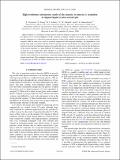High-resolution calorimetric study of the nematic to smectic- A transition in aligned liquid crystal–aerosil gels
Author(s)
Garland, Carl W.; Iannacchione, G. S.
DownloadCruceanu-2009-High-resolution calo.pdf (506.5Kb)
PUBLISHER_POLICY
Publisher Policy
Article is made available in accordance with the publisher's policy and may be subject to US copyright law. Please refer to the publisher's site for terms of use.
Terms of use
Metadata
Show full item recordAbstract
High-resolution ac calorimetry has been used to study the nematic to smectic-A (N-SmA) phase transition in the liquid crystal octylcyanobiphenyl (8CB) confined in aligned colloidal aerosil gels. A stable and robust nematic alignment was achieved by repeated thermal cycling of the samples in the presence of a strong uniform magnetic field. In some ways (such as transition temperature and integrated enthalpy), the dependence of the specific heat peak associated with the N-SmA transition on the aerosil density for aligned gels is consistent with that observed in unaligned (random) gel samples. However, a power-law analysis reveals that the behavior of the critical exponent α is quite different. For random gels, α varies gradually with aerosil density, whereas we find that α for aligned gels shifts abruptly to an XY-like value for the lowest aerosil density studied and remains essentially constant as the sil density increases. This aerosil density independence of α is consistent with the critical behavior of the smectic correlation lengths obtained from an x-ray scattering study of 8CB in aligned aerosil gels. The combined calorimetric and x-ray results indicate that the role of quenched randomness in aligned gels of 8CB+sils differs significantly from that in random gels.
Date issued
2009-01Department
Massachusetts Institute of Technology. Department of ChemistryJournal
Physical Review E
Publisher
American Physical Society
Citation
Cruceanu, F. et al. “High-resolution calorimetric study of the nematic to smectic- A transition in aligned liquid crystal aerosil gels.” Physical Review E 79.1 (2009): 011710. © 2009 The American Physical Society.
Version: Final published version
ISSN
1550-2376
1539-3755